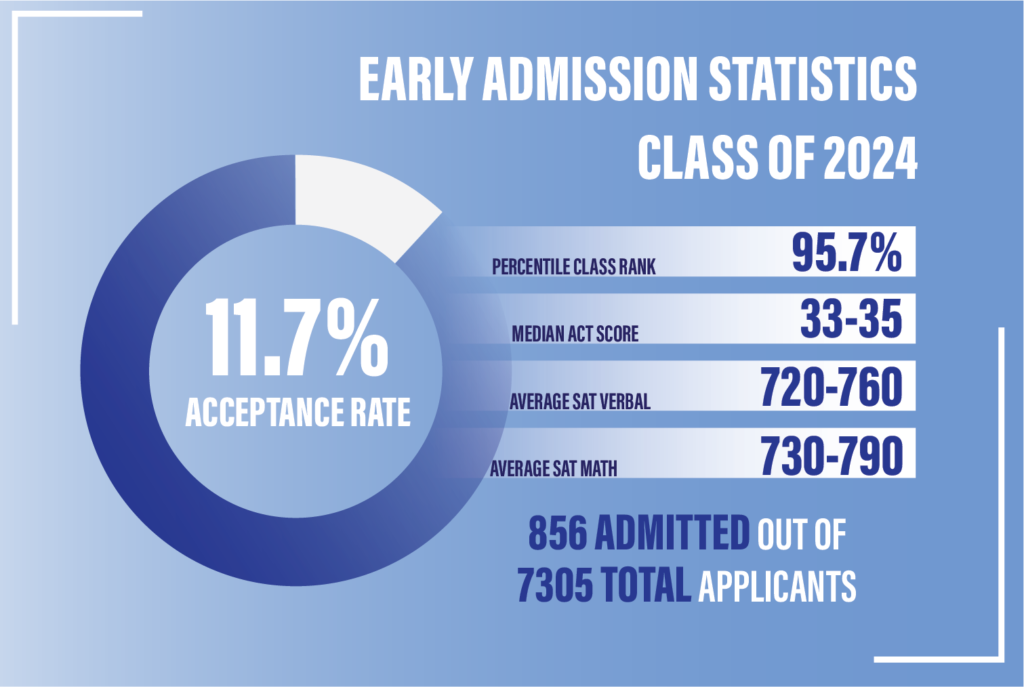
Georgetown University offered admission to 11.72% of early action Class of 2024 applicants, a record low despite the number of applications falling for the second year in a row.
Georgetown accepted 856 students from an applicant pool of 7,305, a 6% decrease from last year’s 7,802 applicants. Early action applicants were notified by mail with either an acceptance or deferral to regular decision Dec. 15.
Of the early applicants, 4,109 applied to Georgetown College, and 450 were accepted at an acceptance rate of 10.95%, the lowest among the four schools. The School of Foreign Service received 1,508 applications and admitted 197 at an acceptance rate of 13.06%. The McDonough School of Business admitted 139 applicants out of 1,106 at an acceptance rate of 12.57%. The School of Nursing and Health Studies received 582 applications, admitting 70 at an acceptance rate of 12.03%.
The College may appeal to potential applicants due to its curricular flexibility, offering the largest selection of majors out of the four schools, according to College Vice Dean Sue Lorenson.
“It doesn’t surprise me that the College has the lowest admit rate,” Lorenson wrote in an email to The Hoya. “For many students, parents, and high school counselors, when they think about ‘Georgetown,’ they’re really thinking about Georgetown College.”
The number of applicants dropped across all four schools for the second consecutive year, according to records provided by Dean of Undergraduate Admissions Charles Deacon (CAS ’64, GRD ’69). The College and the NHS both saw an 8% decrease in applicants, while the SFS experienced a 4% decrease and the MSB experienced a 1% decrease in applications.
Students applying early action to Georgetown may not apply to any binding early decision programs, according to the Office of Undergraduate Admissions website. Early decision programs offered by peer universities may have contributed to Georgetown’s decrease in applicants, according to Deacon.
“We see this as a larger reflection on the continued pressure many applicants are feeling to commit to an Early Decision school, as opposed to a reflection on interest in Georgetown,” Deacon wrote in a letter to The Hoya.
Boston College and the University of Virginia both adopted an early decision program for the first time this admissions cycle. BC and UVA are two of Georgetown’s significant overlap institutions, according to Deacon.
Despite the decrease in applicants, the applicant pool maintained the competitive level and strength of previous years, according to Deacon. Students accepted in this year’s early application cycle generally placed in the top 5% of their class, with the mid-50% of ACT scores ranging between 33 and 35, the mid-50% of SAT verbal ranging between 720 and 760, and the mid-50% of SAT math scores ranging between 730 and 790.
Early action rates have hovered around 12% for the past four years, while the general admissions rate, in its most competitive year, was 14%. The admission rate for early action is purposely kept lower than the general rate to give regular decision applicants a fair chance, Deacon said in an interview with The Hoya.
“We keep the early rate below the overall rate so that we don’t over-admit from the early pool,” Deacon said. “The early pool historically is a little bit more affluent and a little bit more majority students, because students who are lower income, students of color, are usually later in the game, so the larger pool will come later during regular decision.”
This year’s application pool continued to see a growth in applicants from minority groups. Twelve percent of the applicants self-identified as Black/African-American, 14% as Hispanic/Latinx, 20% as Asian-American and 1% as Native American.
Admitted students came from 49 states and 31 countries. The state from which the most applications came was California, followed by Maryland and New York.
The university has continued to offer a non-binding early action program over single-choice early action and early decision alternatives in order to not restrict a student’s options, Deacon said.
“We don’t think that helps anyone, because you can only pick one school,” Deacon said. “That means you only get one financial aid reward, and you have to accept that, and we’ve not felt that was a good plan. You’re only going to get one offer, and it’s not going to be a particularly generous one.”





















Kristen Murphy • Mar 22, 2020 at 2:42 am
White guilt? This is education and regardless of color, no one knows a student’s financial situation. Why does race, colored..have to enter any point of fairness?
reggie 21 • Jan 13, 2020 at 5:59 pm
i seriously hope number of applications continue to fall – is there no other indication than the decrepit facilities finally taking its toll? don’t mind the rats and the mold, but applications should be the least of it. oh, and degioia’s exorbitant salary for posing in a picture, welcoming human rights abusers, and being vague about everything (why is he still relevant?). fix the former and boot the latter and problem solved.
LCHOYA • Jan 11, 2020 at 12:19 pm
I don’t know why this is a surprise to anyone. There is the obvious, the exorbitant cost of tuition and overall expenses towards a degree. But that is necessary to keep Prez DeGioia among the top 1 percenters…what’s his salary now… is it over 2 mil yet. And the basketball coach, that revered position that demands a multimillion $$ salary regardless of performance. But GU has managed to continue increasing minority enrollment. I wonder why that is when all other demographics are dropping? Could it be ‘white guilt’ or even ‘Catholic guilt’ is manipulating the entrance requirements, performance requirements, and sweetening the money pot with freebies like free or very low tuition, grants, etc? If you want to write a relevant article, write one that answers questions, not one that pretends all of this is a mystery.